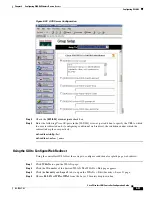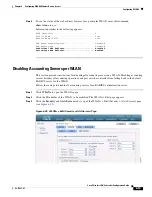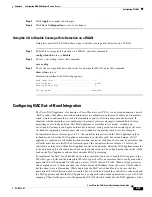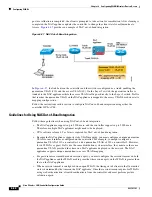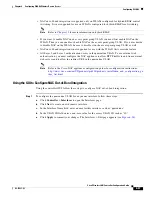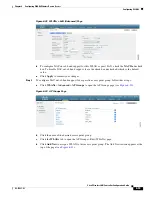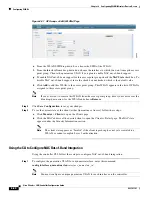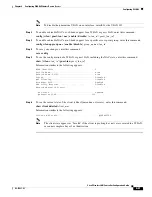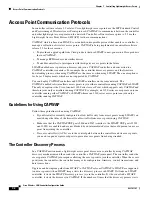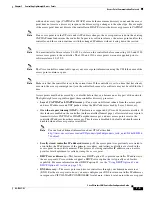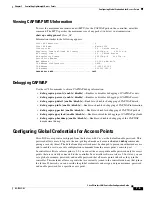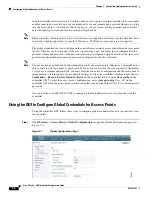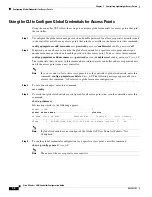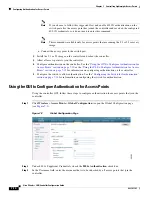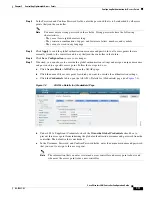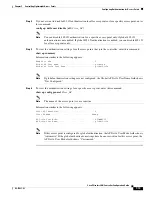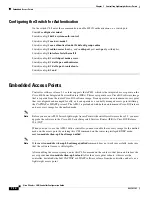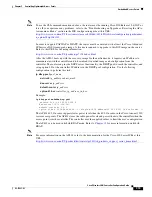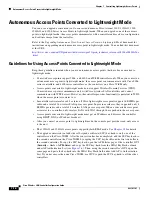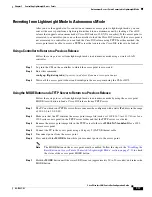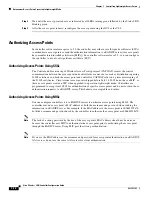
7-3
Cisco Wireless LAN Controller Configuration Guide
OL-17037-01
Chapter 7 Controlling Lightweight Access Points
Access Point Communication Protocols
with one discovery type (CAPWAP or LWAPP) exceeds the maximum discovery count and the access
point does not receive a discovery response, the discovery type changes to the other type. For example,
if the access point does not discover the controller in LWAPP, it starts the discovery process in CAPWAP.
Note
If an access point is in the UP state and its IP address changes, the access point tears down the existing
CAPWAP tunnel and rejoins the controller. In previous software releases, the access point notifies the
controller, and the session continues with the changed IP address without tearing down the session.
Note
You must install software release 4.0.155.0 or later on the controller before connecting 1100 and 1300
series access points to the controller. The 1120 and 1310 access points were not supported prior to
software release 4.0.155.0.
Note
The Cisco controllers cannot edit or query any access point information using the CLI if the name of the
access point contains a space.
Note
Make sure that the controller is set to the current time. If the controller is set to a time that has already
occurred, the access point might not join the controller because its certificate may not be valid for that
time.
Access points must be discovered by a controller before they can become an active part of the network.
The lightweight access points support these controller discovery processes:
•
Layer 3 CAPWAP or LWAPP discovery
—Can occur on different subnets from the access point
and uses IP addresses and UDP packets rather the MAC addresses used by Layer 2 discovery.
•
Over-the-air provisioning (OTAP)
—This feature is supported by Cisco 4400 series controllers. If
this feature is enabled on the controller (on the controller General page), all associated access points
transmit wireless CAPWAP or LWAPP neighbor messages, and new access points receive the
controller IP address from these messages. This feature is disabled by default and should remain
disabled when all access points are installed.
Note
You can find additional information about OTAP at this link:
http://www.ciscosystems.com/en/US/products/ps6366/products_tech_note09186a008093d
74a.shtml
•
Locally stored controller IP address discovery
—If the access point was previously associated to
a controller, the IP addresses of the primary, secondary, and tertiary controllers are stored in the
access point’s non-volatile memory. This process of storing controller IP addresses on an access
point for later deployment is called
priming the access point
.
•
DHCP server discovery
—This feature uses DHCP option 43 to provide controller IP addresses to
the access points. Cisco switches support a DHCP server option that is typically used for this
capability. For more information about DHCP option 43, see the
DHCP Option 60” section on page 7-24
•
DNS discovery
—The access point can discover controllers through your domain name server
(DNS). For the access point to do so, you must configure your DNS to return controller IP addresses
in response to CISCO-LWAPP-CONTROLLER.
localdomain
, where
localdomain
is the access point

